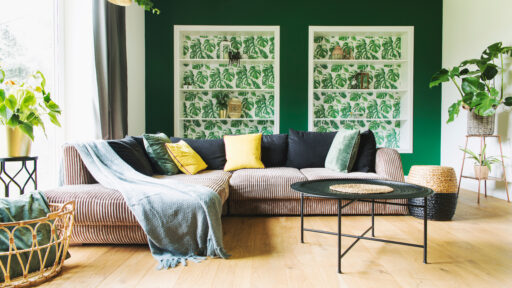Incorporating wood accents and features into your interior design can add warmth and character to your living space. However, mixing and matching different wood tones can be a tricky task. Too many competing wood tones can create a cluttered and overwhelming look, while too much of the same can make your space feel flat and uninteresting.
To help you achieve the perfect balance, we’ve gathered expert tips on how to mix and match wood tones in your interior design. By following these guidelines, you can create a cohesive and inviting atmosphere that showcases the beauty of natural wood elements while avoiding any design headaches.
Mismatched Look Is Fine
Don’t be afraid to mix different wood tones in your home decor. In fact, it’s not just acceptable, but encouraged by design experts. Combining various wood accents and furniture pieces can add depth and warmth to your space.
Moreover, having mismatched wood accents and furniture can give your home a personalized and lived-in look. It’s natural to collect items over time that don’t necessarily match perfectly, and this can add character to your space.
On the other hand, sticking to the same wood tones can make your home look dull and flat.
Mixing wood tones is a simple way to add interest and personality to your home. So don’t be afraid to experiment with different wood accents and furniture pieces to create a warm and inviting space.
Get Creative Using Existing Features
When incorporating wooden furniture or accent pieces into your home, it’s important to consider the dominant wood color in the space. This refers to the wood tone on existing features such as floors, cabinetry, or exposed beams. By selecting additional wood tones that are cohesive with the dominant color, you can create a more harmonious and cohesive look.
If you’re starting from scratch with furnishings in a new space, this is a great place to begin when choosing new wooden pieces. However, if you’re redecorating or swapping out existing items, it’s important to consider how your pieces pair with the dominant wood tones in your home.
To ensure a balanced and visually appealing space, consider creating a mood board or color scheme that incorporates the dominant wood tone and complementary wood tones. This will help guide your furniture and accent piece selections and create a cohesive look throughout your home.
Here are some tips to keep in mind when building off existing wood features in your home:
- Consider the undertones of the dominant wood color and select complementary wood tones that work well together.
- Use a variety of wood tones and textures to add visual interest and depth to your space.
- Don’t be afraid to mix and match different wood finishes, as long as they complement each other.
- Use a color scheme or mood board to guide your selections and ensure a cohesive look throughout your home.
Match the Undertones
To create a cohesive look with different wood tones, it’s important to pay attention to the undertones. Look for similar undertones when mixing wood tones. A good rule of thumb is to stay on the same side of the color spectrum. For instance, if your wood floors have warm undertones, it’s best to add in other wood pieces that also have warm undertones. However, you can add variety with how light and dark the wood is.
Here are some tips to help you mix wood tones with similar undertones:
- If you have warm-toned wood floors, try pairing them with warm-toned furniture pieces such as a cherry wood coffee table or a mahogany bookshelf.
- If you have cool-toned wood floors, try pairing them with cool-toned furniture pieces such as a maple wood desk or a birch wood chair.
- If you want to mix warm and cool tones, try using a neutral wood such as oak or walnut as a bridge between the two.
Remember, there are no absolutes when it comes to mixing wood tones, but paying attention to the undertones can help you create a harmonious and visually appealing space.
Samples Can Help Realize Your Vision
When it comes to pairing wood tones, utilizing samples can be a game-changer. Samples can come from a variety of sources, including your existing furniture or a home improvement store. By gathering samples of different wood tones, you can compare them to the color of your flooring or other dominant wood tones. This allows you to see which wood combos look good together and which pairs you have a good reaction to.
When furniture shopping, bringing a reliable sample with you can be incredibly helpful. By comparing the sample to potential furniture pieces, you can ensure that the final application and pair of tones will be pleasing to you. Taking the time to utilize wood samples can make a big difference in the overall look and feel of your space.
You Don’t Have to do a Full Remodel
If you’re unhappy with the dominant wood tone in your home, there are ways to refresh the space without doing a full remodel. Here are some tips to help you get started:
- Layer rugs: If you’re unhappy with the tone of your flooring, try layering rugs to cover the flooring with textiles that better suit your style. This is an easy and cost-effective way to add color and texture to your space.
- Cabinet reface: Rather than opting for brand new cabinets, consider getting a cabinet reface. A skilled cabinet maker can refinish and apply a paint grade finish or wood veneer, which is a less costly option compared to brand new cabinetry. This is a good alternative when budget is an issue or there is no layout change to the space.
- Fresh coat of paint: Don’t underestimate the power of a fresh coat of paint on the walls. Do some research on which paint colors will best complement the existing wood tones in your home. A new paint color can change your entire perspective and breathe new life into your space.
By refreshing your home with these simple changes, you can achieve a new look without the expense and hassle of a full remodel.






